
Custom Sputter-Coated Filters Are Transforming Machine Vision Applications
JOHN ATKINSON, CHROMA TECHNOLOGY CORP.
For demanding machine vision applications, sputter-coated thin-film interference filters
deliver exemplary performance. Filters for wavelengths from the ultraviolet (UV) to the short-wave infrared (SWIR) boost contrast, enabling an imaging system to acquire more information more efficiently and
at a lower overall system cost.
In the realm of industrial machine vision systems, multiple components play a crucial role in determining the system’s performance. Factors such as illumination, lens, camera, sensor, image processor, and, of course,
filters can significantly impact the
effectiveness of a machine vision setup. Figure 1 shows a typical machine
vision setup that includes certain
components.
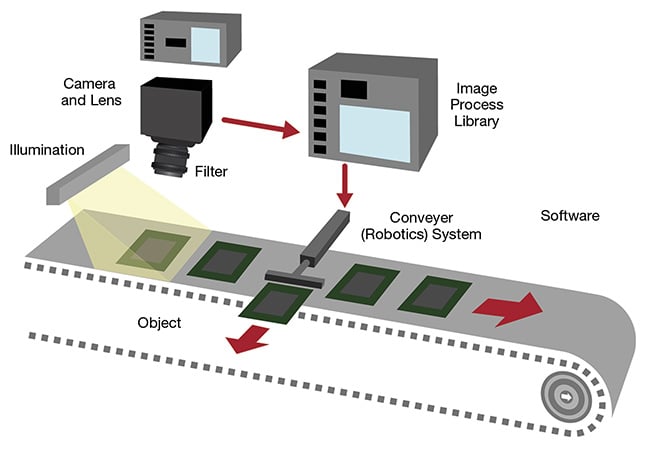
Figure 1. An example of a machine vision system. Courtesy of Chroma Technology Corp.
One essential aspect of machine vision system performance is the role of contrast — the difference in brightness or color between objects or regions within an image. It plays a pivotal role in enabling accurate and reliable image analysis, object detection, and identification.
To enhance the contrast levels in a machine vision system, one powerful
tool is customized filters, which modify the characteristics of light, thereby enhancing contrast. Filters can be
engineered to selectively block or
transmit specific wavelengths, reducing
unwanted noise and increasing the distinction between objects and
their backgrounds. Moreover, these filters can mitigate issues related to reflections, glare, and ambient lighting variations.
By minimizing these undesirable effects, the filters ensure that the captured images contain relevant information, making subsequent image analysis and processing tasks more reliable and efficient.
Interference filters for high precision
While traditional colored glass filters made of absorption glass can help improve contrast, interference filters offer a superior passband shape, making them ideal for high-precision applications. The Gaussian passband shape of a traditional colored glass filter extends beyond the desired spectrum, thereby reducing contrast (Figure 2).
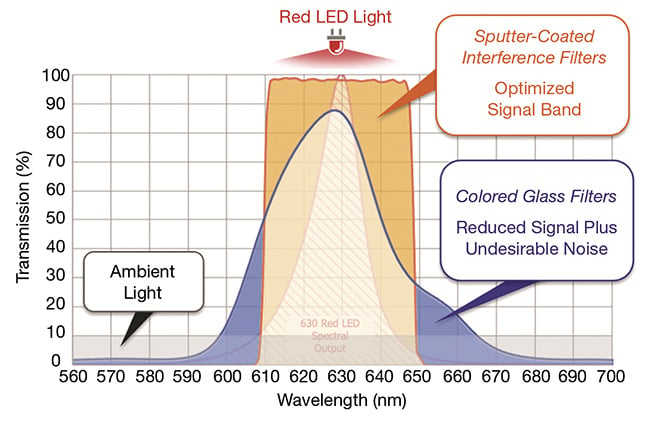
Figure 2. The passband shape of the interference coated filter helps the imaging system achieve increased contrast compared to systems using traditional colored glass filters. Courtesy of Chroma Technology Corp.
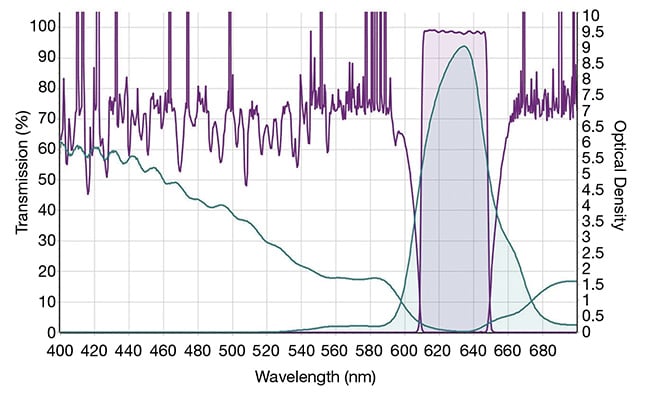
Figure 3. The shaded areas in Figure 3 show the same transmission and passband plots from Figure 2. The unshaded area represents optical density. Courtesy of Chroma Technology Corp.
This difference highlights the performance boost offered by interference filters in current applications and their growing importance in machine vision advancement. Improved contrast can speed up production, increase inspection accuracy, and minimize errors across manufacturing, inspection, warehousing, and logistics applications.
Bandpass filter as a blocking filter
A filter’s main function is to block out-of-band wavelengths. Without blocking, there is no filtration — just transmission.
The shaded areas in Figure 3 show the same transmission and passband plots from Figure 2. The unshaded area represents optical density.
The lower optical density of the green curve in Figure 3 indicates where noise is introduced to the image, diminishing
the contrast ratio. The interference
filter’s optical density, represented by the blue curve, blocks more of the
out-of-band spectrum, transmitting only the targeted bandwidth.
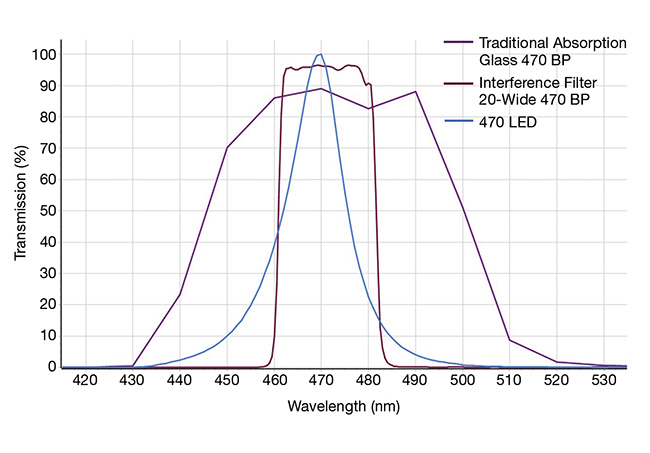
Figure 4. A 470-nm LED spectrum, a traditional ~60-nm-wide bandpass filter, and a 20-nm-wide bandpass filter. Courtesy of Chroma Technology Corp.
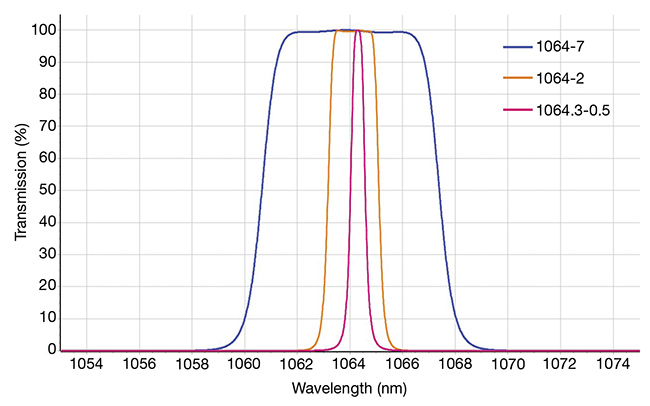
Figure 5. Examples of 1064-nm laser clean-up bandpass filters with full-width half-maximum of 0.5 nm, 2 nm, and 7 nm. Courtesy of Chroma Technology Corp.
Custom solutions: Addressing unique machine vision challenges
1. Custom bandwidth and band
placement
Traditionally, machine vision systems have relied on bandpass filters with bandwidths of 60 nm or more, and generally centered over common LED wavelengths. Narrower bandwidths, for example, between 20 and 40 nm wide, cut out the “tails” of the LED output spectrum where there might also be background light or noise.
For laser applications, an even
narrower band (<20 nm) can be used at the laser source to “clean up” the laser, which might have noisy amplified
spontaneous emission. Figure 5 displays examples of narrow bandpass filters for a 1064-nm laser.
However, there are scenarios in which even narrower bands are essential for optimal results, for example, when dealing with the chemical composition of materials. In these cases, custom filters with extremely narrow bandwidths — between 0.5 and
10 nm — can isolate a spectral signature. These narrow bandpass filters offer advantages in material analysis applications by precisely isolating a sliver of spectral information, enhancing contrast, and improving accuracy.
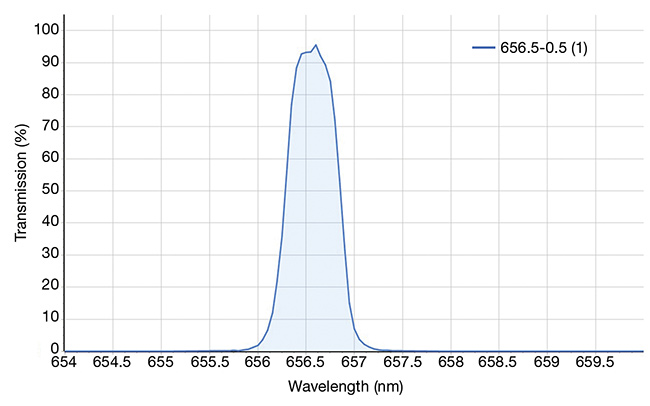
Figure 6. An ultra-narrow bandpass filter for hydrogen detection. Courtesy of Chroma Technology Corp.
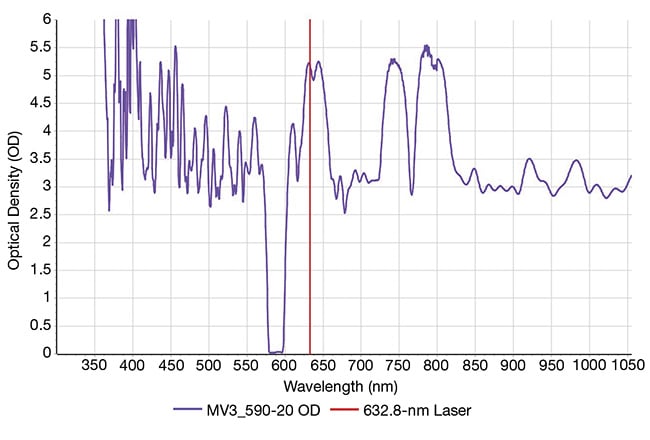
Figure 7. A 590-20 machine vision filter with OD5 blocking of a 632.8-nm helium-neon laser. Courtesy of Chroma Technology Corp.
Characteristics of a Good Machine Vision Filter
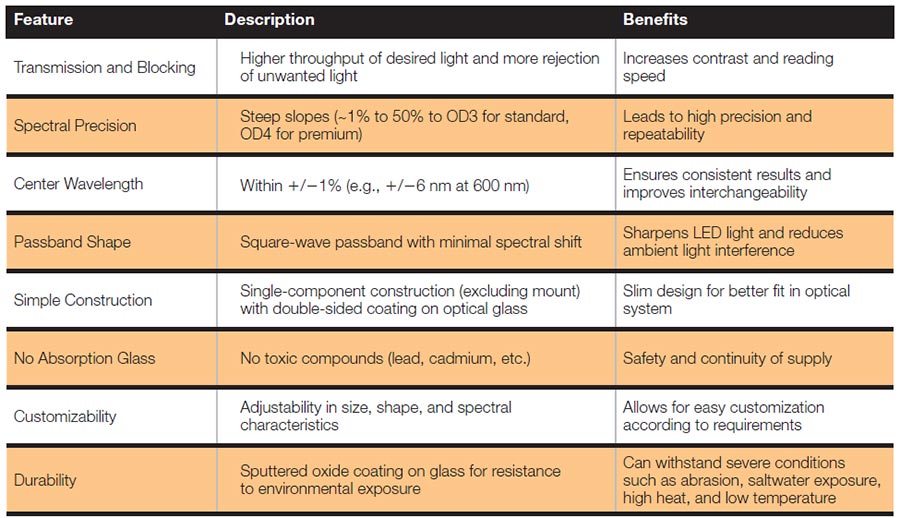
Integrating narrow bandpass filters into machine vision systems for material analysis requires careful consideration of several factors, including the specific application requirements, lighting
conditions, and spectral characteristics of the materials. Customization and optimization play a vital role in achieving the desired performance and maximizing the benefits of these filters in material analysis tasks.
2. Laser light in the field
In the context of machine vision, it is common to encounter scenarios in which laser light is present in the imaging field. For instance, when a laser profiler is used, it becomes crucial to block the laser light to prevent it from overwhelming the captured image. In such cases, it may be necessary to employ filters with a higher optical density to increase attenuation.
Interference filters with a high optical density at the laser line over a wide range of angles can effectively block the laser light from contaminating
the image while maintaining excellent
image quality. Interference filters are easily customizable such that specific
laser wavelengths can have the
required level of blocking without
compromising cost-effectiveness.
Using higher optical density filters with high angle tolerance efficiently blocks laser light, minimizing interference and maximizing visibility and
clarity of desired objects or features in the machine vision system. This enhances analysis accuracy and
reliability, optimizing the system
performance. When dealing with laser light in machine vision applications, it is crucial to consider custom filter solutions. Leveraging interference filters effectively controls the laser light’s impact on the imaging field, ensuring accurate and reliable image analysis while managing costs efficiently.
3. Multiband filters for the sequential use of multiple light sources
In systems with multiple LEDs, the implementation of multiband filters combined with strobing techniques can lead to cost savings by reducing the reliance on expensive cameras. This multispectral approach enables the use of a single camera without the need for a filter wheel.
Various applications can benefit
from using multiband filters alongside multiple LED light sources that are sequentially turned on and off. For
instance, this concept can be
employed to assist with identifying glass, aluminum, and plastic for the sorting and inspection of recycled materials.
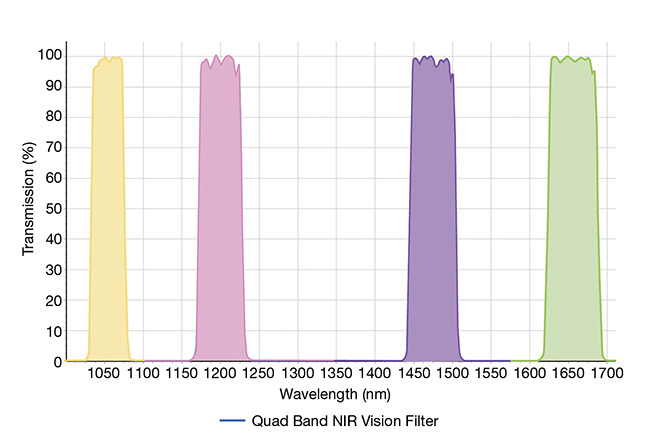
Figure 8. A quad-band machine vision filter spectral transmission. Courtesy of Chroma Technology Corp.
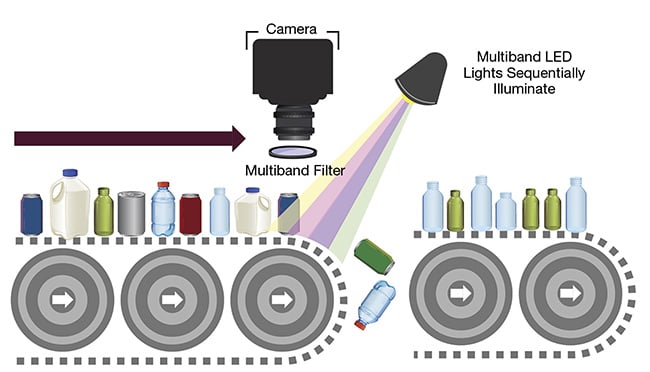
Figure 9. An example of how multiple LEDs strobing sequentially while a camera with a multiband filter captures images can sort recycled materials. Courtesy of Chroma Technology Corp.
The use of multiple bands provided by the multiband filter empowers the inspection system to gather additional information rapidly as the line moves swiftly. This wealth of information is instrumental in distinguishing between desirable and undesirable materials, detecting the presence or absence of certain substances, and even identifying the specific type of material or substance present.
Summary
Even the simplest of warehouse and industrial applications are trending toward higher throughputs, a wider array of objects, and lower tolerance for misruns and read-errors. These factors underscore the growing importance of sputter-coated thin-film interference filters in imaging system design, to optimize the signal-to-noise ratio, contrast, and the modulation transfer function for a specific application.
As more complex machine vision applications are deployed, customized interference filters will help designers manage the complicated illumination issues that currently limit widespread multispectral applications for food inspection, plastic sorting, and robotic guidance.
Meet the author
John Atkinson is principal product
engineer at Chroma Technology Corp. He has a bachelor’s degree in physics and received a master’s degree in
photonics from Boston University. Atkinson has experience in optics, imaging, displays, astrophysics, and optoelectronics; email: [email protected].
/Buyers_Guide/Chroma_Technology_Corp/c2524
Published: September 2023
Glossary
- machine vision
- Machine vision, also known as computer vision or computer sight, refers to the technology that enables machines, typically computers, to interpret and understand visual information from the world, much like the human visual system. It involves the development and application of algorithms and systems that allow machines to acquire, process, analyze, and make decisions based on visual data.
Key aspects of machine vision include:
Image acquisition: Machine vision systems use various...
sputter-coated filtersthin-film interference filtersbandpass filtersFeaturesmachine visionBlocking Filters